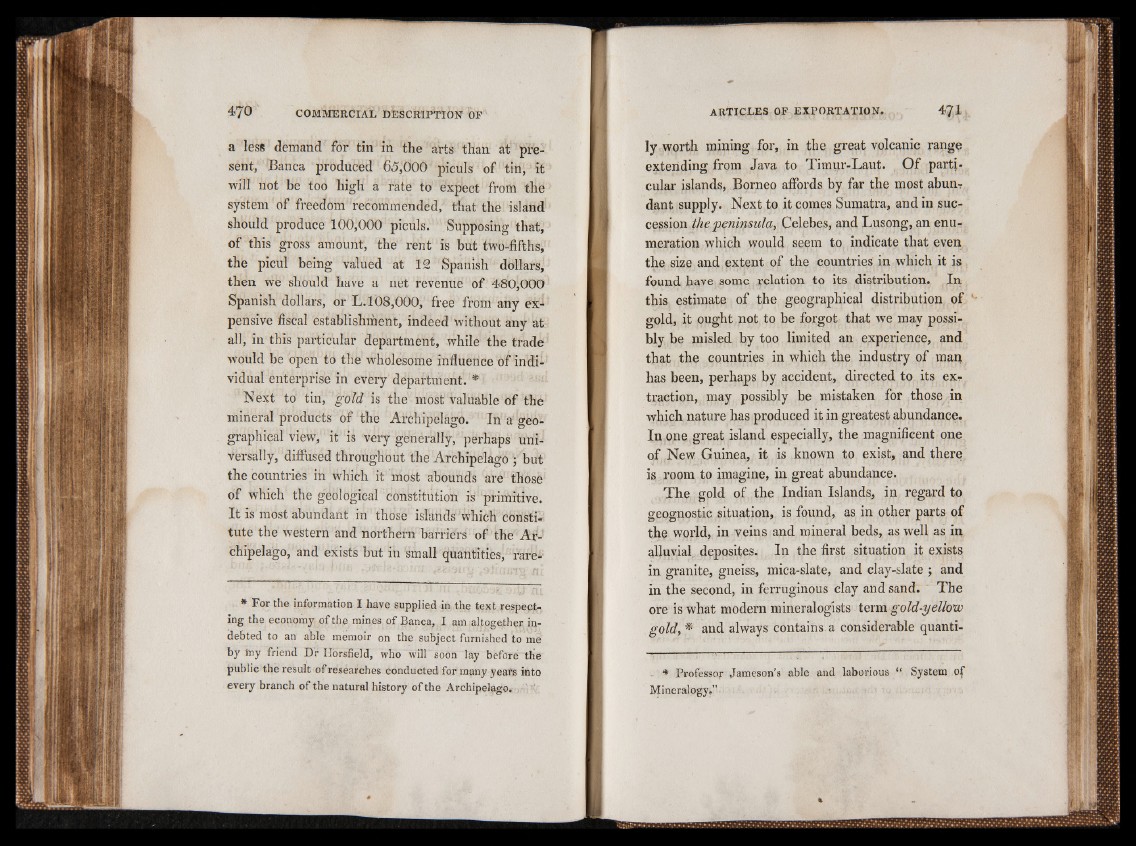
a less demand for tin in the arts than at present,
Banca produced 65,000 piculs of tin, it
will not be too high a rate to expect from the
system of freedom recommended, that the island
should produce 100,000 piculs. Supposing that,
of this gross amount, the rent is but two-fifths,
the picul being valued at 12 Spanish dollars^
then we should have a net revenue of 480,000
Spanish dollars, or L.108,000, free from any expensive
fiscal establishment, indeed without any at
all, in this particular department, while the trade
would be open to the wholesome influence of individual
enterprise in every department. *
Next to tin, gold is the most valuable of the
mineral products of the Archipelago.ri In a geographical
view, it is very generally, perhaps universally,
diffused throughout the Archipelago ; but
the countries in which it most abounds are those
of which the geological constitution is primitive.
It is most abundant in those islands which constitute
the western and northern barriers of the Archipelago,
and exists but in small quantities, rare-
* For the information I have supplied in the text respecting
the economy of the mines of Banca, I am altogether indebted
to an able memoir on the subject furnished to me
by my friend Dr Uorsfield, who will soon lay before the
public the result of researches conducted for many years into
every branch of the natural history of the Archipelago.
ly worth mining for, in the great volcanic range
extending from Java to Timur-Laut. Of particular
islands, Borneo affords by far the most abundant
supply. Next to it comes Sumatra, and in succession
the peninsula, Celebes, and Lusong, an enumeration
which would seem to indicate that even
the size and extent of the countries in which it is
found have some relation to its distribution. In
this estimate of the geographical distribution of
gold, it ought not to be forgot that we may possibly
be misled by too limited an experience, and
that the countries in which the industry of man
has been, perhaps by accident, directed to its extraction,
may possibly be mistaken for those in
which nature has produced it in greatest abundance.
In one great island especially, the magnificent one
of New Guinea, it is known to exist, and there
is room to imagine, in great abundance.
The gold of the Indian Islands, in regard to
geognostic situation, is found, as in other parts of
the world, in veins and mineral beds, as well as in
alluvial, deposites. In the first situation it exists
in granite, gneiss, mica-slate, and clay-slate ; and
in the second, in ferruginous clay and sand. The
ore is what modern mineralogists term gold-yellow
gold, * and always contains a considerable quanti*
Professor Jameson’s able and laborious “ System of
Mineralogy,”- &